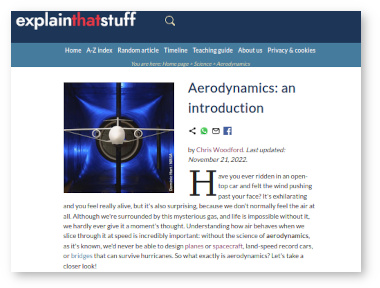

Web work

“All in all, a great website for students and technology aficionados who want to learn something new.”
The Times of India, 28 September 2017.
“... other websites stood out... [including] ExplainthatStuff!
written by British science writer Chris Woodford. Beyond these, there was little that I
thought provided credible and useful information to the casual learner.”
Andrew Maynard, "Is nanotech failing casual learners?", Nature Nanotechnology, September 2016, p.734.
“If you are fed up with fobbing off your child's scientific questions, try websites such as Explainthatstuff! (www.explainthatstuff.com) or HowStuffWorks (www.howstuffworks.com)...”
Toby Young and Miranda Thomas, What Every Parent Needs to Know, Penguin, 2014.
“We found Explainthatstuff.com's explanation of both batteries and electricity to be the best source for understanding and explaining the science behind the two topics..”
STEM in Libraries, 2016.
It's important to keep reaching new audiences in new ways. In 2006, I set up the educational website Explain that Stuff, where I publish around 400 free science and technology articles.
By September 2015, the site was serving over 1.6 million pages a month to around 800,000 readers, with traffic equally divided between North America, Europe, and Asia. It's clocked up over 140 million "page views" so far.
The site has proved popular—and not just in terms of visitor numbers. When Wikipedia (the default source of reference) clutters, quibbles, and confuses, people warm to clear, simple, engaging explanations that instantly make sense. 95 percent of readers sending feedback have rated the articles either "excellent" or "good". It's been particularly exciting to see Explain that Stuff reaching so many young, would-be scientists in Africa and Asia, parts of the world long neglected by traditional western publishers.
Articles and artworks from the site have been widely reused under licence by schools, colleges, universities, exam boards, scientific organizations, environmental groups, and educational publishers. They've been cited by dozens of books and over 2000 academic papers and patents.
In 2011, I added a Facebook page to the site, where I publish fun science snippets from time to time.